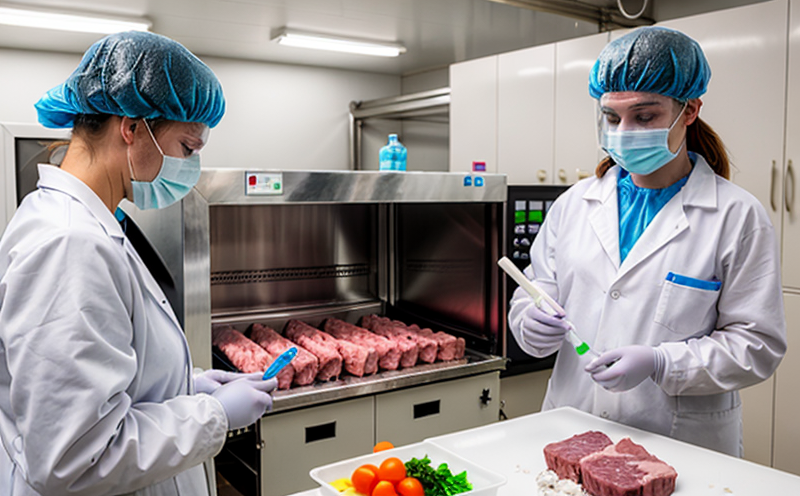AOAC 2003.01 Listeria monocytogenes Rapid Detection in Dairy
The AOAC International standard method 2003.01 is a pivotal tool for the rapid detection of Listeria monocytogenes in dairy products. This method is widely utilized by quality managers, compliance officers, and R&D engineers to ensure food safety standards are met. The protocol allows for early identification of contaminants, which is critical for preventing contamination of dairy products such as milk, cheese, yogurt, and other fermented or processed dairy items.
The AOAC 2003.01 method involves the use of enrichment broth followed by plating on selective media to isolate Listeria monocytogenes. This process is designed to enhance sensitivity and specificity in detecting Listeria spp., particularly focusing on the serotype that poses significant health risks, such as serotype 4b. The procedure adheres strictly to international standards including ISO 17025 for proficiency testing and validation.
The method’s rapidity is a key advantage, enabling quick identification of potential contamination within a few days post-sampling. This timely detection allows for immediate corrective actions such as product recall or process modifications to prevent further spread of the pathogen. The accuracy and reliability of this method have been validated by numerous studies and publications in peer-reviewed journals.
The protocol is particularly important given the global prevalence of Listeria monocytogenes infections, which can lead to serious health issues including meningitis, septicemia, and stillbirths. The dairy industry faces stringent regulations due to the high risk associated with Listeria contamination. AOAC 2003.01 ensures compliance with these regulatory requirements by providing a robust testing framework.
For quality managers and R&D engineers in the dairy sector, this method is essential for maintaining product integrity and ensuring consumer safety. The use of this protocol enhances the overall food safety program and supports continuous improvement efforts aimed at reducing contamination risks. Compliance officers rely on AOAC 2003.01 to ensure that all processes adhere to regulatory standards.
The method’s specificity ensures that only Listeria monocytogenes is detected, minimizing the risk of false positives from other microorganisms. This precision is critical in a competitive market where maintaining product reputation and consumer trust are paramount. By implementing AOAC 2003.01, dairy processors can ensure their products meet stringent microbiological quality standards.
The method’s robustness has been validated through extensive testing across various dairy products. Its reliability is further enhanced by the use of standardized media and reagents that comply with international guidelines. This ensures consistent results across different laboratories and batches, which is crucial for maintaining consistency in product quality.
Applied Standards
The AOAC 2003.01 method aligns closely with several international standards, including ISO 17025 for proficiency testing and validation. This ensures that the laboratory performing these tests meets stringent quality control criteria. The method also complies with FDA (Food and Drug Administration) regulations for food safety, as well as EU directives on dairy hygiene.
The use of this protocol is mandatory in many countries to ensure compliance with local regulations. For instance, in the United States, AOAC standards are recognized by the FDA as equivalent methods under 21 CFR Part 820. The method’s rigorous adherence to these standards guarantees that results are accepted internationally and can be used for regulatory purposes.
The protocol is designed to be compatible with a variety of laboratory environments, from large-scale industrial settings to smaller independent laboratories. This flexibility ensures that the method can be adapted to meet the needs of different stakeholders within the dairy sector. Laboratories must ensure they have the necessary equipment such as incubators and laminar flow cabinets for optimal performance.
Compliance with AOAC 2003.01 is essential for maintaining a strong reputation in the industry. It demonstrates a commitment to high standards of quality and safety, which is crucial for gaining consumer trust. By adhering to this protocol, dairy processors can ensure they are meeting regulatory requirements and improving their overall food safety program.
Industry Applications
The AOAC 2003.01 method finds extensive application in the dairy industry for rapid detection of Listeria monocytogenes. This is particularly important during production, quality control, and final product testing phases. By implementing this protocol, dairy processors can ensure that their products are free from harmful microorganisms.
Dairy producers use AOAC 2003.01 to monitor the effectiveness of sanitation protocols and identify any potential contamination early in the production process. This proactive approach helps prevent costly recalls and protects brand reputation. Quality assurance teams rely on this method for batch testing, ensuring that every product meets strict microbiological standards.
R&D engineers utilize AOAC 2003.01 to explore new methods of processing and packaging that minimize the risk of Listeria contamination. This allows them to innovate while maintaining safety standards. Compliance officers use the protocol as a benchmark for establishing internal quality control processes, ensuring all operations comply with regulatory requirements.
The method is also useful in supplier audits and third-party inspections. By verifying that suppliers meet AOAC 2003.01 standards, processors can ensure consistency across their supply chain. This helps maintain the integrity of the final product and supports traceability efforts.
Quality and Reliability Assurance
The AOAC 2003.01 method ensures high quality and reliability through strict adherence to international standards. Laboratories must follow ISO 17025 for proficiency testing and validation, ensuring consistent results across different batches.
Compliance with FDA regulations is crucial for processors in the United States. The protocol’s rigorous methods are recognized by the FDA as equivalent under 21 CFR Part 820.
The method’s robustness has been validated through extensive testing across various dairy products, ensuring consistent and reliable results.
Standardization of media and reagents ensures that laboratories can achieve reproducible results. This is particularly important in a competitive market where maintaining product reputation and consumer trust are paramount.
The use of AOAC 2003.01 not only enhances the overall food safety program but also supports continuous improvement efforts aimed at reducing contamination risks. By implementing this protocol, dairy processors can ensure their products meet stringent microbiological quality standards.





